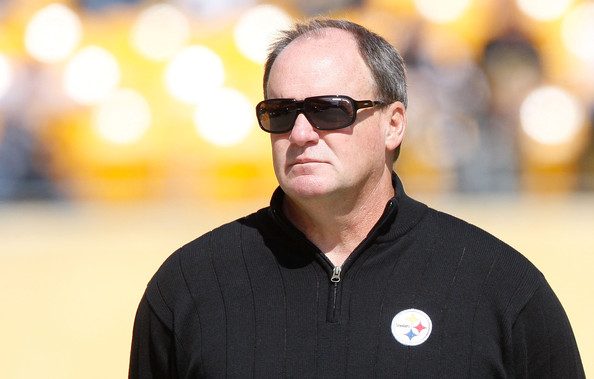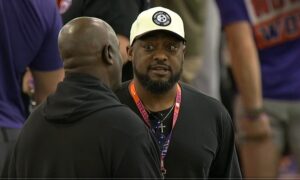As the NFL free agent frenzy is set to begin in a matter of days, brain trusts league-wide are prepared to bust out the checkbooks and throw exorbitant amounts of dough at players who, more or less, won’t live up to the amount of zeroes and probably won’t see the lifespan of the fine print. This isn’t, and never has been, the Pittsburgh Steelers preferred path, as they choose to build the team through the draft. The results should speak for themselves, as since 2000 they’ve advanced to three Super Bowls, capturing two Lombardi Trophies, with only one losing season. Only one other team can say the same, and that’s the freshly minted Super Bowl champion New England Patriots.
It’s no coincidence that in that same year, Kevin Colbert was hired as the director of football operations and has since taken over as general manager.
The only blip occurred during the 2003 season, where the team’s 6-10 record landed it the 11th overall pick in the 2004 NFL Draft, and they used that on franchise quarterback and cornerstone Ben Roethlisberger.
Stability is and always has been big with the Rooney family, and one need look no further for evidence than the amount of coaches the team has seen since 1969, and that’s three.
“They maintain the same standards throughout,” Colbert said of the Rooneys. “People like myself, who join at whatever point we do, or Coach Bill Cowher or Coach Mike Tomlin, we join into the organization. You may lend your own individual ideas and philosophies, but as a whole the organizational philosophy has been there and you’re just fortunate enough to join in for however long you do.”
Colbert has been the steady hand that’s guided the ship though, replenishing the depth chart shelves time and again. Although not often mentioned among the Ted Thompson’s or Ozzie Newsome’s when it comes to the NFL general manager hierarchy, his results speak for themselves. Look at their first round draft hits since he has taken the reigns; Plaxico Burress, Casey Hampton, Troy Polamalu, Roethlisberger, Heath Miller, Lawrence Timmons, and Maurkice Pouncey, just to name a few.
Of course not every draft can be a total success though, and no GM is immune to it.
“There’s no way you go into it saying, ‘We’ll take a chance here and hope,'” he said. “No. We’re trying to do as much work as we can to make sure the picks we make have the best chance to succeed.”
He compared it to baseball, saying the ideal draft is to go 3-for-3, not 1-for-3, and for every Limas Sweed, there’s an Antonio Brown, or for every Rashard Mendenhall a Le’Veon Bell. It’s not at all a perfect science, but Colbert has far more hits than misses.
There’s more that goes into it for Colbert, more than just All-American status, or Butkus Awards or 40 times at the combine. There’s a lot of prying under rocks, and taking a look at what burns from within a player.
“The tangible football evidence, I don’t want to say it’s easy, but it’s easier than the intangibles because you can watch a film. You can time a 40 yard dash. You can measure a vertical jump,” he said. “But to really measure someone’s intelligence, character, loyalty, ability to get along, is a very difficult aspect of what we try to do.”
This has rang true the last few years, as the team has been more lenient than in the past, of willing to forgive and forget a player’s checkered past. Look no further than Mike Adams and the Ohio State debacle, or LeGarrette Blount last offseason. There are a number in this year’s draft, one in particular in talented cornerback Marcus Peters, who could be very intriguing for the team if all checks out.
“If the kid has an issue or a character concern you try to sort out and determine what are the actual facts, be it a police record or a school violation, something where you can say, ‘this happened.’ We then have to measure the risks of whether or not we feel this player can overcome those challenges,” he said.
He also noted how sometimes even the players with a spotless “Boy Scout” resume can lull you to sleep, then turn around to bite you, so extra homework needs to be done.
Which leads to the war room itself, and how all personnel decisions are made, and he’s the first to note the cohesion that’s required of himself and Tomlin to be on the same page.
“Coach Tomlin has to deal with different issues on a day-to-day basis than I do,” he said.
It would be easy for him to draft a player with a problematic past, and simply say ‘Hey, here are the keys to the car, go coach him up’ but that’s not his job, it’s Tomlin’s.
“You can’t be afraid to make suggestions or present ideas that may not challenge what you’ve done in the past, but maybe enhance what you’ve done in the past, and hope that it works.”
One thing that has worked, and been a great success the past few years is the team’s history of unearthing wide receivers from the mid-to-late rounds and helping them blossom into stars in the league. Mike Wallace, Emmanuel Sanders, and Antonio Brown? Pro-Bowlers all of them, with youngster Martavis Bryant very possibly the next one.
“There are a lot of reasons that people are successful and it’s not you,” Colbert said. “As a successful organization it’s never one person and if you understand that, you’ll always appreciate others’ efforts going toward that common goal.”
And that common goal is the Super Bowl, with the proof in the pudding, as the team has two of them since Colbert arrived.
“You understand each other’s duty and you try to support it as best you can because you’re all fighting for one goal and that is to win the Super Bowl and nothing else.”








